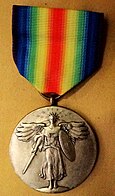
Back Medalla de la Victòria a la I Guerra Mundial (Estats Units) Catalan مدال پیروزی جنگ جهانی اول Persian World War I Victory Medal (États-Unis) French מדליית הניצחון במלחמת העולם הראשונה (ארצות הברית) HE Medaglia interalleata della vittoria (Stati Uniti d'America) Italian 第一次世界大戦戦勝記念章 Japanese Overwinningsmedaille (Verenigde Staten) Dutch Медаль Победы в Первой мировой войне (США) Russian World War I Victory Medal (United States) SIMPLE I. Dünya Savaşı Zafer Madalyası Turkish
| World War I Victory Medal | |
|---|---|
 | |
| Type | Service medal |
| Awarded for | "service between April 6, 1917, and November 11, 1918, or with either of the following expeditions:
|
| Description | A medal of bronze 36 millimeters in diameter. On the obverse is a winged Victory standing full length and full face. On the reverse is the inscription The Great War for Civilization and the coat of arms for the United States surmounted by a fasces, and on either side the names of the Allied and Associated Nations. The medal is suspended by a ring from a silk moire ribbon 1 3/8 inches in length and 36 millimeters in width, composed of two rainbows placed in juxtaposition and having the red in the middle, with a white thread along each edge. |
| Country | |
| Presented by | Secretary of War and Secretary of the Navy |
| Eligibility | Military personnel only |
| Motto | The Great War for Civilization |
| Status | Obsolete |
| Established | 1919 |
| Precedence | |
| Next (higher) | Mexican Border Service Medal |
| Next (lower) | Army of Occupation of Germany Medal |
The World War I Victory Medal (known prior to establishment of the World War II Victory Medal in 1945 simply as the Victory Medal) was a United States service medal designed by James Earle Fraser of New York City under the direction of the Commission of Fine Arts.[1]
Award of a common allied service medal was recommended by an inter-allied committee in March 1919.[2] Each allied nation would design a 'Victory Medal' for award to their military personnel, all issues having certain common features, including a winged figure of victory on the obverse and the same ribbon.[3]
The Victory Medal was originally intended to be established by an act of Congress. The bill authorizing the medal never passed, however, thus leaving the military departments to establish it through general orders. The War Department published orders in April 1919, and the Navy in June of the same year.[1]
- ^ a b Wyllie, Robert E. (1921). Orders, Decorations and Insignia, Military and Civil. New York and London: G. P. Putnam's Sons. pp. 16, 30, 48, 56, 66, 72, 83–90. OCLC 1279226. OL 7102953M – via Internet Archive.
- ^ The Type I Victory Medal 1914-1919. Richard Flory. Orders & Medals Research Society Journal, September 2009, page 145
- ^ Joslin, Litherland and Simpkin. British Battles and Medals. pp. 230-1. Published Spink, London. 1988.